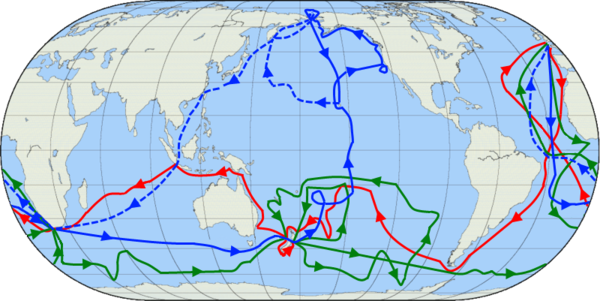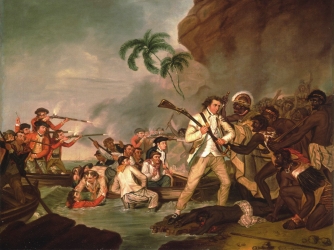Captain James Cook: England's Supreme Explorer, Mapmaker Part 2: Subsequent VoyagesCook had married in 1762, on December 21, to Elizabeth Batts. The couple eventually had six children. Their son George was born in 1772, five days before James left on his second voyage of scientific exploration. The purpose of this second voyage was again to find Terra Australis. The ship Cook commanded on this voyage was the Resolution; accompanying that ship was the Adventure, commanded by Tobias Furneaux. In January 1773, the two ships became one of the first ever to cross the Antarctic Circle. A brush with Antarctic fog separated the two ships, and the Adventure went off course and ended up in New Zealand. Cook forged on, continuing to explore what we now call Antarctica. It was on this second voyage that Cook successfully put to use the recent invention the marine chronometer, a device created by John Harrison and emulated by Larcum Kendall that could help naval captains determine their longitude while at sea. Cook returned to new Zealand in 1774 and then made a tour of other Pacific islands, including Easter Island before returning home. Cook’s third voyage began in 1778, with the purpose being to discover the Northwest Passage, which most European explorers believed existed as a way to go around North America at the very northern end. Along the way, Cook, in command again of Resolution, made landfall at what is now Hawaii. His first landfall was on the island of Kauai in January 1778. He named the islands the Sandwich Islands, after the fourth Earl of Sandwich, who was then the First Lord of the Admiralty.
Cook was buried at sea. His crew completed the voyage, returning home in 1780. The map below shows the routes of Cook's voyages. Red marks the first voyage; green marks the second voyage; the third voyage is in blue.  Captain James Cook left a strong legacy filled with strong achievement. He increased the world’s collective knowledge of the geography of many countries and lands and, especially, the flora and fauna of those countries and lands. Botanists Joseph Banks and Daniel Solander were on Cook’s first voyage of discovery, and between them they cataloged more than 3,000 plant species; as well, artists depicted these new lands and species in drawings that were remarkably accurate for their time. Based on his own and his crew’s observations, Cook theorized that the Polynesian peoples he visited originated in Asia; later scientific discoveries proved Cook correct in this hypothesis. One sailor who served under cook went on to live in a bit of infamy. This was William Bligh was captain of the ship called the HMS Bounty in 1787, when the crew mutinied. |
|

 Cook and company sailed north and east and explored the western coast of North America, making landfall on the Oregon coast and going farther north, exploring what is now the western Canadian coastline. He went through the Bering Strait, went up and down the Siberian coast, and then returned to Hawaii in 1779. The captain and the crew made landfall on the “Big Island,” Hawaii, at Kealakekua Bay. The sailors stayed for a month, then set out again. Just after they left, however, they had to return because the ship’s foremast broke. This time around, relations between the Europeans and Hawaiians were not so good. A group of Hawaiians took a small boat that belonged to Cook and his crew. Cook responded by threatening violence, then went into the heart of a nearby village with the intent of kidnapping and ransoming the King of Hawaii, who at that time was Kalaniopuu. This effort ended badly for Cook, as the Hawaiians turned on him and killed him and four of his men, also wounding two others.
Cook and company sailed north and east and explored the western coast of North America, making landfall on the Oregon coast and going farther north, exploring what is now the western Canadian coastline. He went through the Bering Strait, went up and down the Siberian coast, and then returned to Hawaii in 1779. The captain and the crew made landfall on the “Big Island,” Hawaii, at Kealakekua Bay. The sailors stayed for a month, then set out again. Just after they left, however, they had to return because the ship’s foremast broke. This time around, relations between the Europeans and Hawaiians were not so good. A group of Hawaiians took a small boat that belonged to Cook and his crew. Cook responded by threatening violence, then went into the heart of a nearby village with the intent of kidnapping and ransoming the King of Hawaii, who at that time was Kalaniopuu. This effort ended badly for Cook, as the Hawaiians turned on him and killed him and four of his men, also wounding two others.
